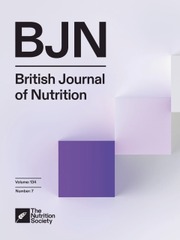Article contents
Vitamin E and the risk of pneumonia: using the I2 statistic to quantify heterogeneity within a controlled trial
Published online by Cambridge University Press: 26 October 2016
Abstract
Analyses in nutritional epidemiology usually assume a uniform effect of a nutrient. Previously, four subgroups of the Alpha-Tocopherol, Beta-Carotene Cancer Prevention (ATBC) Study of Finnish male smokers aged 50–69 years were identified in which vitamin E supplementation either significantly increased or decreased the risk of pneumonia. The purpose of this present study was to quantify the level of true heterogeneity in the effect of vitamin E on pneumonia incidence using the I2 statistic. The I2 value estimates the percentage of total variation across studies that is explained by true differences in the treatment effect rather than by chance, with a range from 0 to 100 %. The I2 statistic for the effect of vitamin E supplementation on pneumonia risk for five subgroups of the ATBC population was 89 % (95 % CI 78, 95 %), indicating that essentially all heterogeneity was true variation in vitamin E effect instead of chance variation. The I2 statistic for heterogeneity in vitamin E effects on pneumonia risk was 92 % (95 % CI 80, 97 %) for three other ATBC subgroups defined by smoking level and leisure-time exercise level. Vitamin E decreased pneumonia risk by 69 % among participants who had the least exposure to smoking and exercised during leisure time (7·6 % of the ATBC participants), and vitamin E increased pneumonia risk by 68 % among those who had the highest exposure to smoking and did not exercise (22 % of the ATBC participants). These findings refute there being a uniform effect of vitamin E supplementation on the risk of pneumonia.
Keywords
- Type
- Full Papers
- Information
- Copyright
- Copyright © The Author 2016
References
- 10
- Cited by



